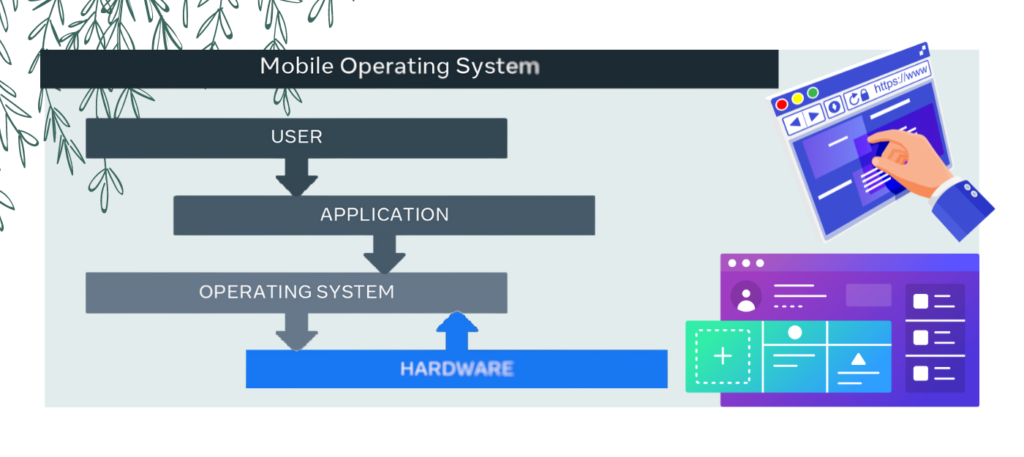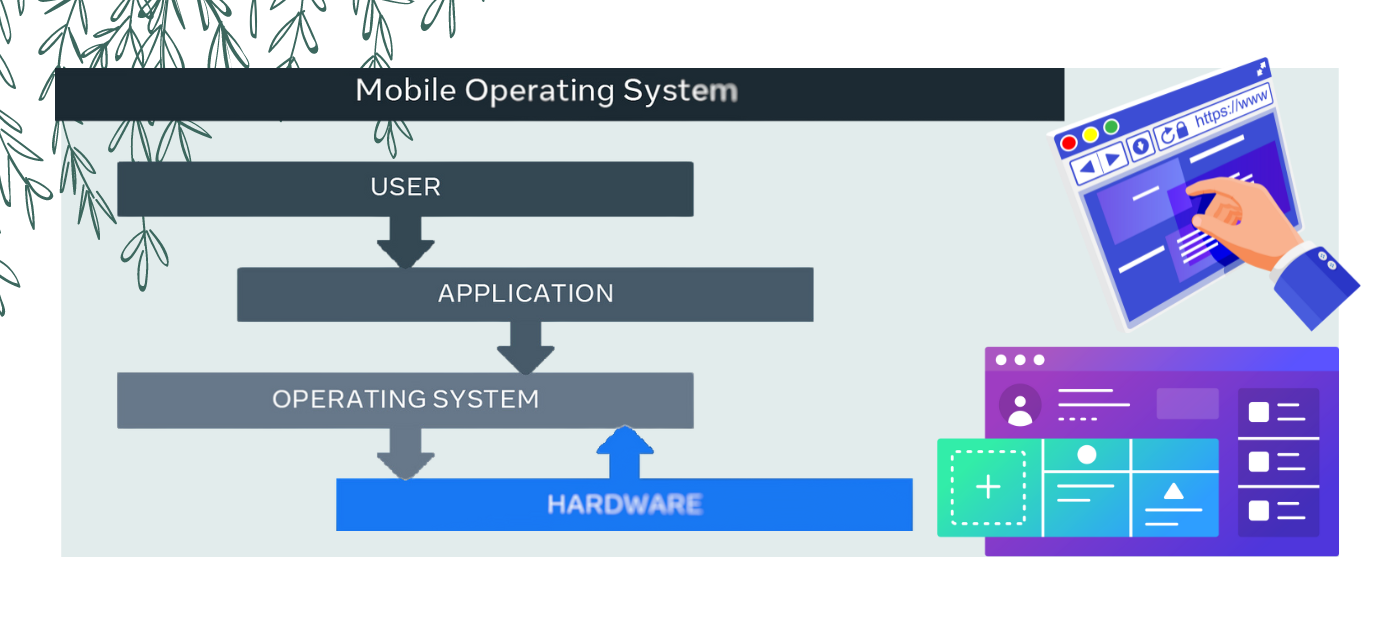How Phone Operating Systems Work
Introduction
Phone operating systems (OS) are essential software that manage all hardware and software resources on smartphones. They provide a user interface and enable applications to run. Popular phone operating systems include Android, iOS, and a few others like Windows Phone and BlackBerry OS. This guide will explain how these operating systems work and their key features. How Phone Operating Systems Work
Table of Contents
Key Components of Phone Operating Systems
- Kernel: The core part of the OS, responsible for managing the device’s resources, such as memory, CPU, and hardware components. It acts as a bridge between the software and hardware.
- User Interface (UI): This is what users interact with. It includes the home screen, icons, touch gestures, and visual elements that make the device user-friendly.
- Application Framework: This layer provides APIs (Application Programming Interfaces) that developers use to create apps. It includes various services and libraries for tasks like handling touch input, managing application lifecycles, and rendering graphics.
- System Services: These are background services that handle essential functions like networking, data storage, and security.
- Hardware Abstraction Layer (HAL): This layer abstracts hardware specifics, allowing the OS to work with different hardware components without needing to know the details of how each component works.
- Drivers: Software that allows the operating system to communicate with the hardware components, such as the camera, sensors, and display.
How Phone Operating Systems Work
- Booting Up: When you power on your phone, the bootloader, a small program, is executed. It initializes the device’s hardware and loads the kernel into memory.
- Kernel Operation: The kernel initializes the system and starts core services. It manages the device’s hardware, schedules processes, and handles memory management.
- User Interface Initialization: Once the core system is up and running, the OS initializes the user interface. This includes loading the home screen, system apps, and any customizations.
- Application Management: The OS manages the lifecycle of applications, ensuring they have the resources they need to run efficiently. It handles multitasking, where multiple apps run simultaneously, by efficiently managing memory and processing power.
- System Services Operation: Various system services run in the background to handle tasks like internet connectivity, notifications, and updates. These services ensure the smooth operation of the device without user intervention.
- User Interaction: Users interact with the OS through touch, voice commands, and other input methods. The OS processes these inputs, updates the UI, and executes the appropriate actions.
Popular Phone Operating Systems
- Android:
- Open Source: Developed by Google and based on the Linux kernel.
- Customizability: Highly customizable with support for various hardware configurations.
- Google Services Integration: Deep integration with Google services like Gmail, Google Maps, and the Google Play Store.
- Apps: Supports a vast range of applications available on the Google Play Store.
- iOS:
- Exclusive to Apple Devices: Developed by Apple for iPhones, iPads, and iPods.
- User Experience: Known for its smooth and intuitive user experience.
- Security: High emphasis on security and privacy.
- Ecosystem Integration: Seamless integration with other Apple devices and services like iCloud, iMessage, and Apple Music.
- Windows Phone (Discontinued):
- Tile-based UI: Known for its unique tile-based user interface.
- Microsoft Services: Integration with Microsoft services like OneDrive, Outlook, and Office.
- Limited App Support: Faced challenges due to a smaller app ecosystem.
- Security: Known for its robust security features.
- Physical Keyboard: Featured physical keyboards on many devices.
- Business Focus: Targeted towards business and enterprise users.
Conclusion
Phone operating systems are complex pieces of software that make smartphones functional and user-friendly. They manage the device’s hardware, provide a user interface, and support the running of applications. Understanding how they work helps in appreciating the seamless experience they offer and the technological advancements behind modern smartphones.
Detailed Components and Functions of Phone Operating Systems
1. Kernel
The kernel is the heart of any operating system, and it manages the communication between hardware and software. In phone operating systems:
- Process Management: The kernel handles the creation, scheduling, and termination of processes. It ensures that each application gets adequate CPU time to run.
- Memory Management: The kernel manages the phone’s RAM, ensuring that applications have enough memory to run while also optimizing the use of available memory.
- Device Drivers: The kernel includes drivers that allow the operating system to communicate with hardware components such as the display, camera, and sensors.
2. User Interface (UI)
The UI is what users interact with directly:
- Home Screen: The central part of the UI where users access apps and widgets.
- Touch Gestures: Allows users to interact with the device through touch inputs like taps, swipes, and pinches.
- Notifications: Displays alerts and messages from apps and the system.
- Settings: A section where users can customize the device, including network settings, display options, and app permissions.
3. Application Framework
The application framework provides the building blocks for developers to create apps:
- Activity Manager: Manages the lifecycle of applications, ensuring they start, run, and stop efficiently.
- Content Providers: Manage access to data stored on the device, such as contacts or media files.
- Resource Manager: Handles resources like UI layouts, strings, and graphics that apps need.
- Notification Manager: Allows apps to display alerts and notifications to users.
4. System Services
System services run in the background to perform essential functions:
- Connectivity Services: Manage Wi-Fi, Bluetooth, and mobile network connections.
- Location Services: Provide location data using GPS, cell towers, and Wi-Fi signals.
- Battery Management: Monitor and optimize battery usage to extend battery life.
- Security Services: Protect the device from malware and unauthorized access.
5. Hardware Abstraction Layer (HAL)
The HAL acts as a bridge between the operating system and the hardware:
- Standardization: Provides a standard interface for hardware components, allowing the OS to support different hardware configurations.
- Isolation: Isolates hardware-specific code from the rest of the operating system, making it easier to update and maintain.

6. Drivers
Drivers are specialized software that control hardware components:
- Display Drivers: Manage the display output, including screen resolution and brightness.
- Camera Drivers: Control the camera hardware, enabling photo and video capture.
- Audio Drivers: Manage audio input and output, including speakers, microphones, and headphones.
- Sensor Drivers: Interface with sensors like accelerometers, gyroscopes, and proximity sensors.
How Phone Operating Systems Work
Working of Specific Phone Operating Systems
1. Android
- Architecture: Android is built on the Linux kernel and includes a rich set of libraries and APIs written in C, as well as a Java-compatible virtual machine.
- Customizability: Android is highly customizable, allowing manufacturers to modify the OS to suit their devices.
- App Ecosystem: The Google Play Store provides access to millions of apps, making Android devices highly versatile How Phone Operating Systems Work.
2. iOS
- Architecture: iOS is built on the XNU kernel, which is a hybrid of the Mach and BSD kernels. It includes core services, media, and Cocoa Touch layers.
- User Experience: Known for its smooth and intuitive user interface, iOS is designed for ease of use and seamless integration with other Apple products.
- Security: Apple’s stringent app review process and robust security features help protect users from malware and data breaches How Phone Operating Systems Work.
Advanced Features and Technologies
1. Artificial Intelligence (AI)
Modern phone operating systems integrate AI to enhance functionality:
- Voice Assistants: Siri on iOS and Google Assistant on Android use AI to understand and respond to user commands.
- Predictive Text: AI algorithms predict the next word or phrase a user is likely to type, improving typing speed and accuracy.
- Personalization: AI learns user behavior and preferences to provide personalized content and recommendations.How Phone Operating Systems Work,
2. Augmented Reality (AR)
Both Android and iOS support AR technologies:
- ARCore (Android) and ARKit (iOS): Frameworks that allow developers to create AR experiences, overlaying digital content on the real world through the phone’s camera.
- How Phone Operating Systems Work
3. Security Enhancements
Phone operating systems include advanced security features:
- Biometric Authentication: Fingerprint scanners, facial recognition, and iris scanners enhance security and ease of access.
- Encryption: Data on the device is encrypted to protect against unauthorized access.
- App Sandboxing: Apps run in isolated environments to prevent them from accessing each other’s data.
Conclusion
Phone operating systems are complex systems that manage all aspects of a smartphone’s functionality. From handling hardware resources with the kernel to providing a user-friendly interface and supporting a vast range of applications, these operating systems are essential for the modern mobile experience. Understanding how they work provides insight into the seamless and powerful technology behind the devices we use every day.How Phone Operating Systems WorkHow Phone Operating Systems Work
How Phone Operating Systems WorkHow Phone Operating Systems WorkHow Phone Operating Systems WorkHow Phone Operating Systems WorkHow Phone Operating Systems Work

Can you be more specific about the content of your article? After reading it, I still have some doubts. Hope you can help me.
I don’t think the title of your article matches the content lol. Just kidding, mainly because I had some doubts after reading the article.